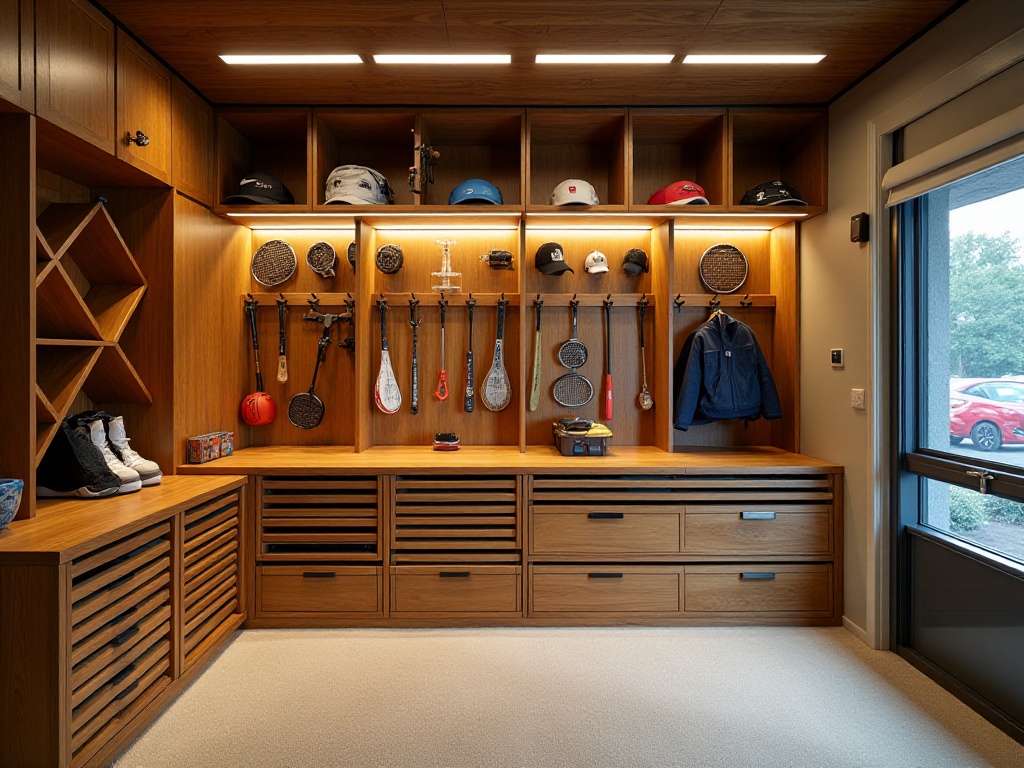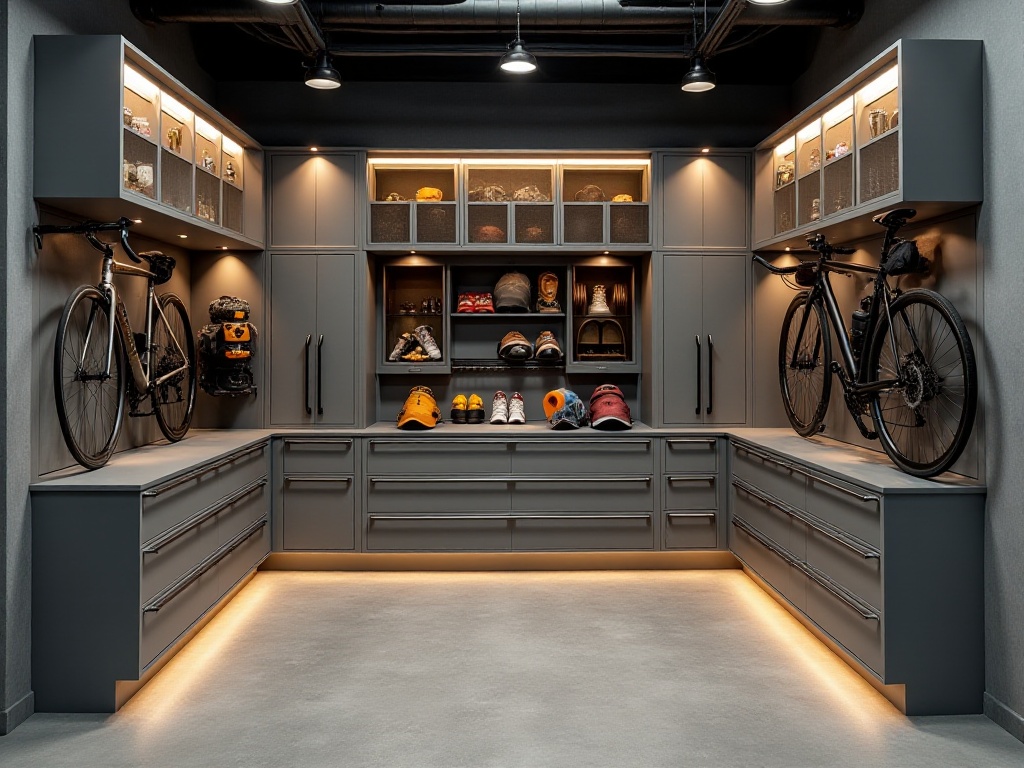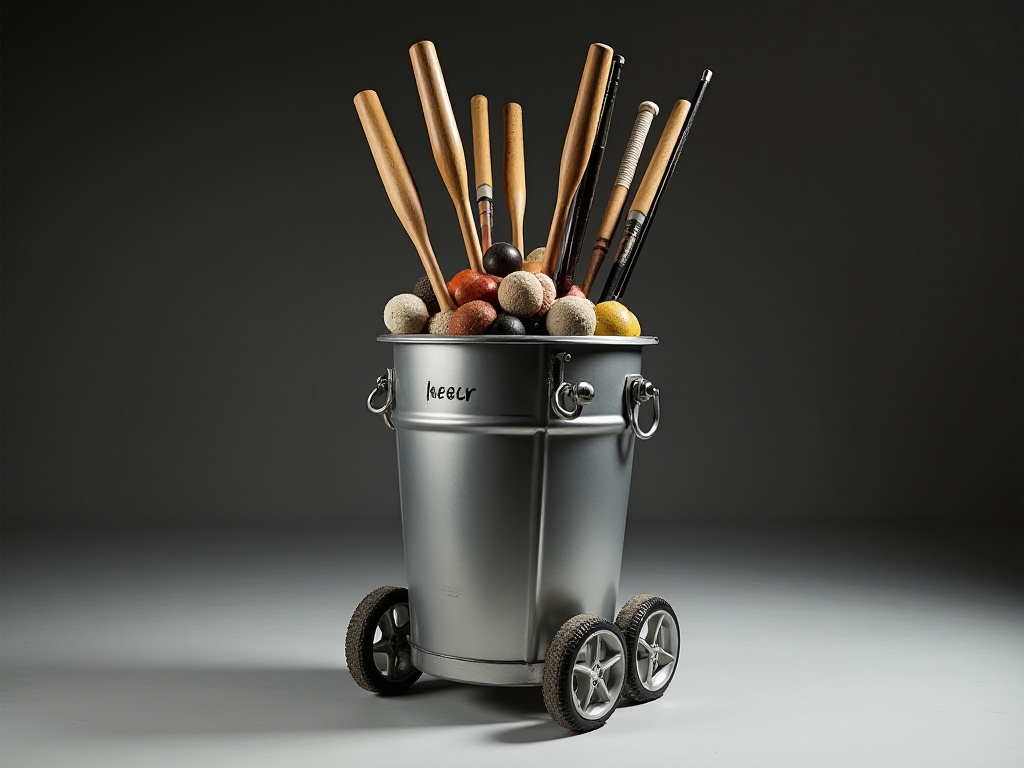Opening Thoughts
As a sports enthusiast, my home was bursting with sports equipment. Recently, my room was literally a battlefield of sports gear: my beloved limited edition basketball was carelessly left in the sun on the balcony (oh no, this would surely ruin it); my expensive badminton racket lay pitifully on the sofa, silently reproaching my irresponsibility; as for my rolled-up yoga mat, it had been hiding under the bed for almost a month, gathering dust. Every time I wanted to exercise, finding equipment was like going on an adventure - often finding one thing but missing another, almost making me lose my enthusiasm for working out.
However, now I've completely bid farewell to that chaotic state. Through years of trial and improvement, I've finally found an ultra-practical sports equipment storage solution. Today, let me share my insights to help fellow enthusiasts who face similar struggles solve this headache-inducing problem.
Wall Utilization
Honestly, before I started researching storage solutions, I never imagined walls could be such excellent storage spaces. Looking back, I wasted so much potential space. After some research, I installed a super cool hook system on one wall of my living room. This system is incredibly flexible, allowing adjustment of hook positions and angles according to different equipment sizes and shapes.
I hang my basketballs and soccer balls using specially designed S-hooks. These hooks have excellent weight-bearing capacity and are covered with non-slip silicone sleeves to prevent damage to the balls. What I particularly love is that these hooks can be freely adjusted in angle, allowing for optimal hanging positions based on ball sizes.
For my tennis and badminton rackets, I chose professional racket holders. These holders are cleverly designed, not only securely fixing the rackets but also considering weight distribution to prevent any damage. Plus, the bottom of the holder has a small storage compartment for tennis or shuttlecocks, making them easily accessible.
This wall storage not only gives each piece of sports equipment its proper place but also transforms the entire wall into a super cool sports-themed wall. Every time friends visit, they're attracted to this wall and express their desire to replicate it at home. Most importantly, this storage method completely frees up floor space, eliminating worries about tripping over scattered sports equipment.
Ceiling Usage
The most exciting storage discovery I made was utilizing ceiling space. Honestly, before discovering this technique, I never thought the ceiling could be used this way. Now I've transformed my garage ceiling into a super powerful storage space.
I installed a track storage system in the garage, which is truly a game-changer. It consists of several sturdy metal tracks and matching storage boxes that can move along the tracks. When needed, you can easily pull down the contents. I store less frequently used equipment like winter skiing gear and summer ice hockey protective gear in these boxes. Each storage box has a dust cover and is transparent, making it easy to see what's inside.
What I'm most proud of is my bicycle storage solution. I installed a pulley system on the ceiling that can hoist up the entire bicycle. This system includes two sets of pulleys and a sturdy steel cable, plus a locking mechanism. To use it, you just hook the cable to specific points on the bicycle, then gently pull the rope on the other end, and the bicycle slowly rises. When the bicycle reaches the appropriate height, the locking mechanism automatically secures it.
This system not only saves a lot of floor space but is also very convenient to use. Best of all, I installed a small tool rack next to the pulley system, specifically for storing air pumps, wrenches, and other maintenance tools, making everything within reach when using or maintaining the bicycle.
Mobile Storage
As someone who often exercises with friends, I deeply understand the importance of a good mobile storage solution. After multiple attempts and improvements, I finally found the perfect mobile storage solution for myself.
I keep three different-sized collapsible storage boxes in my car trunk, each for different sports equipment. The largest one is specifically for ball sports equipment like basketballs, soccer balls, and volleyballs, with a small compartment for air pumps and needles. The medium-sized box is for various rackets and related accessories, with added padding to prevent damage during transport. The smallest one is for personal items like wristbands, knee pads, and sports towels.
Each storage box is labeled and color-coded for easy identification. The boxes are foldable, saving space when not in use. Plus, they're all waterproof, so there's no worry about equipment getting wet in the rain.
What I find most thoughtful is that these storage boxes have wheels at the bottom, making them as easy to pull as luggage. The boxes are also designed with shock absorption in mind, so there's no worry about equipment damage even on rough roads.
Drawer Organization
When it comes to storage, drawers are definitely indispensable helpers. I dedicated a five-drawer chest specifically for storing sports-related small items, and after careful planning and organization, each drawer is now perfectly ordered.
I chose a bamboo drawer divider set that can be freely combined, with the advantage of adjusting compartment sizes as needed. In the top drawer, I organize various protective gear by function. The left side is for wristbands, where I have several pairs of different materials for various sports; the middle is for knee pads, including professional sports knee pads and some simple elastic ones; the right side is for ankle supports. Each area is clearly labeled, and I intentionally left space for instruction manuals, so I won't forget the correct usage methods.
The second drawer is dedicated to sports socks. I categorize socks by different sports types: running socks, basketball socks, tennis socks, etc. I bought the same style for each type of sock, so I don't have to worry about finding matching pairs. To maintain drawer tidiness, I learned some sock-folding tricks to keep them neat and space-efficient.
The third drawer is the sports accessories area, containing various headbands, sweatbands, sports watches, and pedometers. I use small transparent storage boxes to categorize these accessories, protecting them from damage while making them easy to find.
The bottom two drawers are used for spare sports items, such as spare shoelaces, racket strings, and anti-slip tapes. These items aren't used often but come in handy when needed. I also placed some desiccants in the drawers to prevent moisture damage to these spare items.
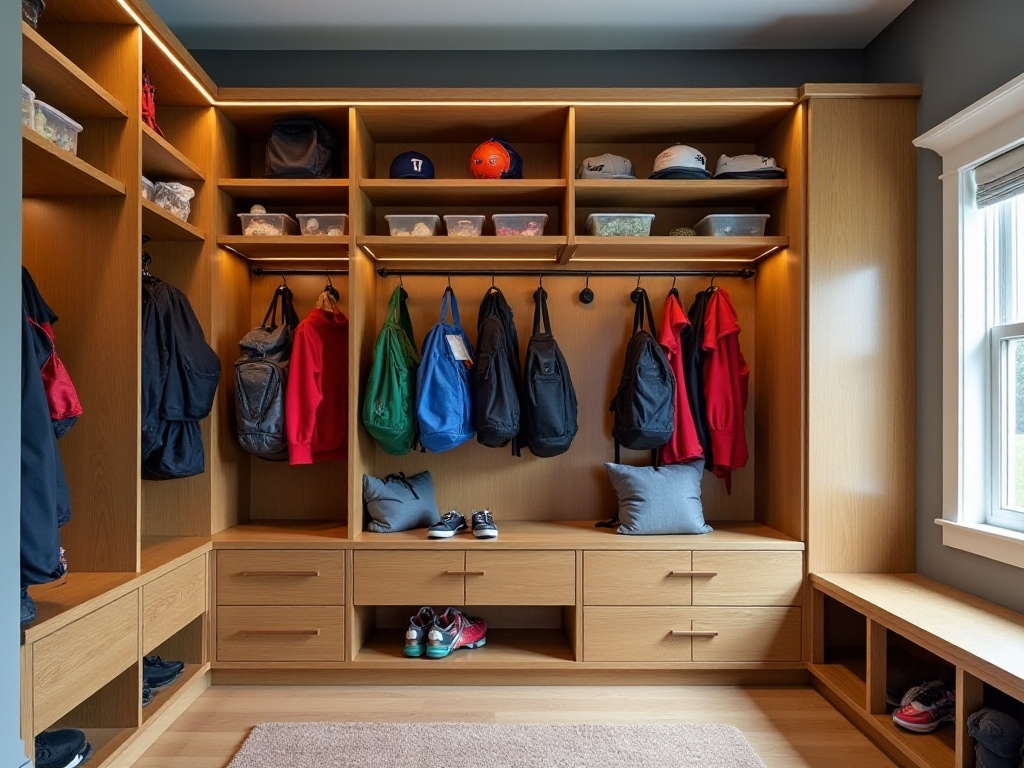
Cleaning and Maintenance
Honestly, before I started seriously organizing sports equipment, I never realized how important cleaning and maintenance were. Now I have developed a complete cleaning and maintenance routine that I follow after every workout.
First is the basic cleaning of equipment. I use specialized sports equipment cleaners that don't contain harsh chemicals, effectively cleaning without damaging the equipment. For items like basketballs and soccer balls, I gently wipe the surface dust and sweat with a slightly damp cloth, then dry with a dry cloth, maintaining the ball's surface and extending its lifespan.
Cleaning protective gear is crucial, as these items easily trap sweat and bacteria. I hand wash items like wristbands and knee pads that get sweaty easily with mild detergent, then air dry them in a ventilated area. Never use a dryer, as this might damage the elastic materials. Before storing, I ensure the protective gear is completely dry to prevent mold and odors.
For special sports equipment like ice hockey gear, cleaning requirements are stricter. After each use, I completely unfold the equipment and air it out in a well-ventilated place. Sometimes I use professional sports equipment deodorizer, which not only removes odors but also prevents bacterial growth. This step is especially important in summer.
I've also established regular deep cleaning schedules for each type of equipment. For example, I re-grip rackets monthly and give my bicycle a thorough cleaning and maintenance, including chain washing and oiling, every three months. While these regular maintenance tasks might seem troublesome, they significantly extend equipment lifespan.
Categorized Storage
Scientific categorization is key to improving storage efficiency. After multiple adjustments and optimizations, I finally found the categorization method that works best for me.
First is categorization by frequency of use. I divided all sports equipment into three categories: items used weekly are placed in the most accessible locations, like running shoes in the most visible spot in the shoe cabinet; items used several times monthly are in secondary locations, like tennis rackets on the living room racket rack; rarely used items can be stored on top of storage boxes or in the basement, like skiing equipment during summer.
Then there's categorization by sport type. I use different colored storage boxes for different sports: red boxes for basketball-related equipment, blue for badminton gear, green for tennis items, and yellow for running equipment. This color-coding system helps me quickly find needed equipment.
To better manage these categories, I created a detailed list recording the storage location of each item. I keep this list on my phone, so I can quickly check where things are when needed. Plus, this list helps me track equipment usage frequency and adjust storage locations accordingly.
For small items that easily get mixed up, I use transparent storage boxes, allowing me to see the contents without opening them. Each storage box has detailed labels indicating what's inside and any special notes.
Practical Advice
Through years of exploration, I've accumulated many particularly useful tips, all gathered from practical experience.
First is about storing bicycle helmets. I found that keeping the helmet with the bicycle is most scientific, as this way you won't forget to wear it when going cycling. I installed a special helmet rack in the garage right next to the bicycle for easy access. The helmet rack design is thoughtful, with a small tray at the bottom for storing gloves and other cycling accessories.
Pump placement is also particular. I keep one at home and one in the car. The home pump is placed in an easily accessible location, like next to the shoe cabinet, so I can immediately handle flat balls or bicycle tires. The car pump I chose is compact but fully functional, stored in a dedicated spot in the trunk, ready to use whenever needed.
For easily lost small accessories like ball needles and tennis clips, I keep spares in a fixed location. These spare parts are stored in a small box clearly labeled with its contents, so I don't have to worry about not finding them when needed.
Sports shoe storage also requires attention. I arrange shoes according to different sports characteristics. For example, running shoes are in the entrance shoe cabinet for easy access during morning runs, while basketball shoes are stored with the balls so I won't forget them when going to play.
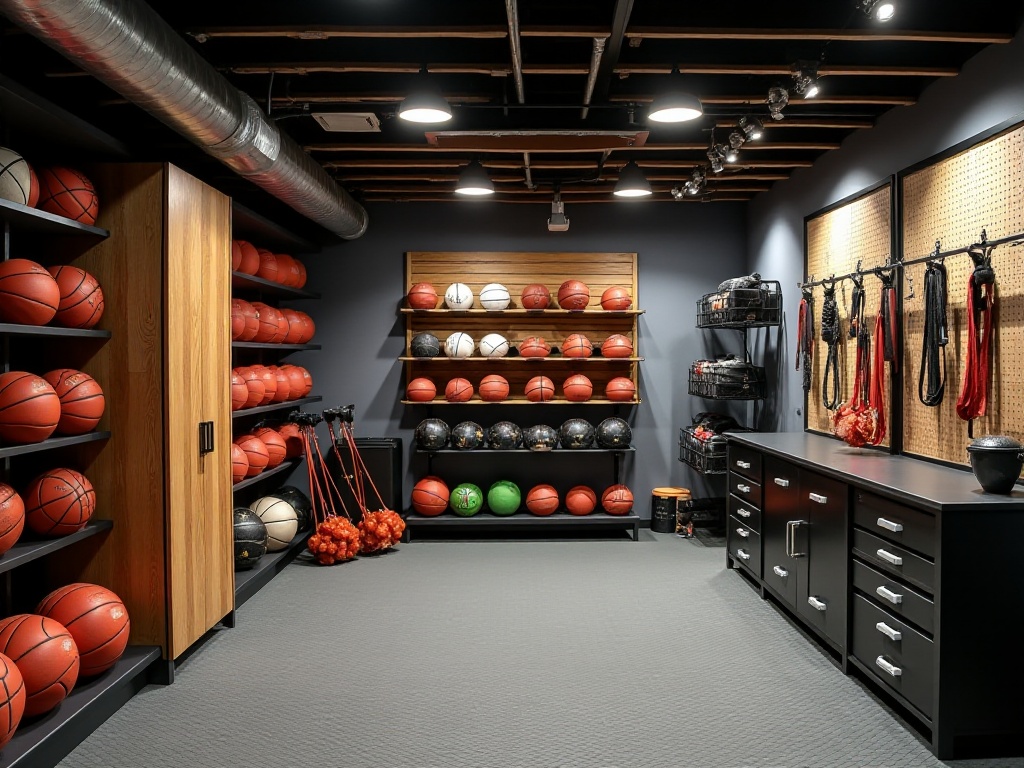
Creative Modifications
Sometimes ready-made storage products don't fully meet our needs, and that's when creativity comes in handy for making our own modifications.
My proudest creation is a ball storage rack made from plywood and elastic cords. This storage rack was inspired by gym equipment racks, with a main slanted frame and elastic cords spaced at regular intervals. Balls fit securely in the spaces created by the elastic cords and can be easily removed with a gentle pull. This storage rack is not only practical but also inexpensive, using materials available at any hardware store.
Another particularly useful modification was converting an old sorting trash bin into a sports equipment storage tower. I thoroughly cleaned the bin and added several removable dividers inside, creating a multi-layer storage space. The top layer holds jump ropes, the middle layer stores chalk and protective gear, and the bottom layer holds miscellaneous items. This storage tower has a small footprint and includes a lid for dust and moisture protection.
I also modified an old bookshelf into a sports equipment display rack. I lined each shelf with non-slip mats to prevent equipment from sliding. I also added hooks to the backboard for hanging lightweight equipment. This display rack is not only practical but also attractive, serving as a decorative element in the living room.
Experience Sharing
Through years of practice, I deeply understand the importance of a good storage system for an active lifestyle. It's not just about keeping the home tidy; it makes the entire sports experience more enjoyable and efficient.
When you can immediately find the equipment you need without searching everywhere, you'll find that exercising becomes more natural and relaxed. Without worrying about finding things or equipment maintenance, you can focus more on the exercise itself. Plus, seeing your sports equipment neatly arranged creates a sense of achievement that inspires greater enthusiasm for exercise.
I think the most important thing is to establish a storage system that matches your usage habits. For example, I love ball sports, so my storage system particularly emphasizes ball equipment storage and maintenance. The system should also be flexible enough to adjust as your exercise habits change.
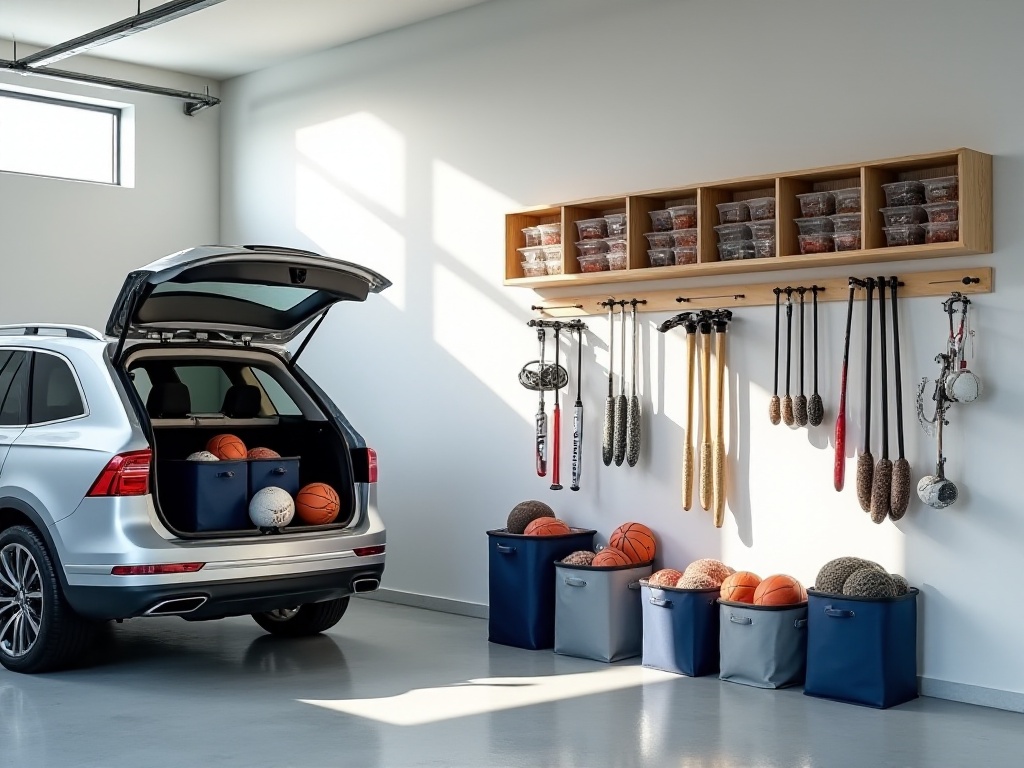
Concluding Thoughts
Honestly, sports equipment storage is an ongoing optimization process. My current storage solution took countless adjustments to develop, and I believe it will continue to improve. Everyone has different living habits and home layouts, so suitable storage solutions naturally differ.
I hope my sharing provides some inspiration for friends struggling with sports equipment storage. Storage itself can be fun, like playing a space planning game. When you gradually establish your own storage system and watch cluttered equipment transform into a neat landscape, that sense of satisfaction is really great.
If you have any good storage tips, feel free to tell me in the comments. Let's make sports equipment storage simpler and more interesting together, making our active lifestyles even better!




